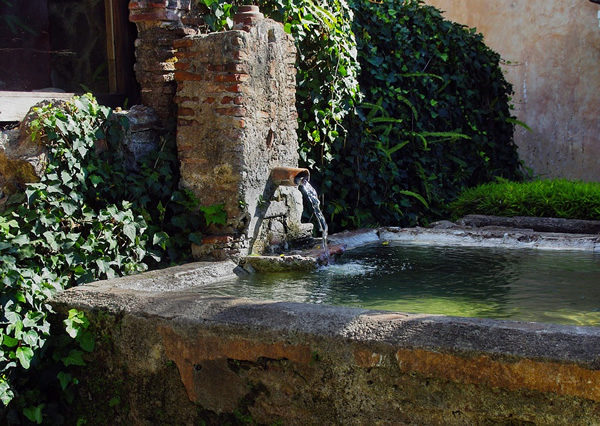Art, Mayan Crafts, and Travel Writing Workshops in Guatemala
By John Brandon

|
|
A fresh water fountain in Antigua, Guatemala.
|
I hadn't ridden in the back of pickup truck, packed elbow to elbow with a dozen other people, since the 1960s. I'd never climbed an active volcano, made tortillas over an open fire or smoked cigars in a Mayan ceremony. I'd never traveled to Central America. And, I'd never found the time to take a writing course. Art Workshops in Guatemala provided all of the above and much more.
The key to understanding what Art Workshops in Guatemala offers is found in its mission statement: "Art Workshops in Guatemala strives to provide a new and renewing experience for creative souls. Through contact with a world so different from our own we expand our horizons not only artistically but also in many other ways."
Art Workshops in Guatemala is based in La Antigua Guatemala, a small (pop. 50,000) city an hour's drive from the international airport in Guatemala City. Surrounded by three massive volcanoes, Antigua holds the unique distinction of being both an UNESCO World Heritage and Monument of the Americas site. These designations ensure that Antigua's cobblestone streets and colonial buildings will remain unchanged for future generations to enjoy.
With an economy based on tourism, Antigua is filled with intriguing shops, galleries, museums and native markets to explore when your workshop has finished for the day. Internet cafes make contact with home easy and inexpensive. Tourist friendly banks are located on the central plaza, with competitive rates for the exchange to Guatemalan Quetzals.
Restaurant options abound, ranging from traditional Guatemalan food to Mexican, Italian, Thai, and the increasingly ubiquitous International cuisine. And, as the home to dozens of Spanish language schools, Antigua presents a great opportunity to practice/learn/improve your Spanish. It's hard to imagine a more wonderful base camp.
The Art Workshops course schedule included Portraiture: Photographing the Soul of Indigenous Guatemala, Loom Beading: A Painterly Approach, and New Directions in Travel Writing.
On our first morning, about 20 eager students from the U.S. and Canada shared a Guatemalan breakfast in Casa Grande, the big house, a beautiful private residence complete with inner courtyard that would serve as our central meeting place, as well as home to many of the participants. Any doubts that we would leave Guatemala without making new friends were eliminated.
Conversations flowed easily as we devoured tropical fruits, spicy breakfast sausage and freshly squeezed orange juice. As one student remarked near the end of the course, " I had not thought about it, but the group was already self-selected to those people I would be interested in spending time with."
New Directions in Travel Writing met in the great room of the Clark House, another private residence that also provided lodging for participants. Our instructor was Richard Harris, author or co-author 28 guidebooks, including Hidden Guatemala. Richard clearly loves Guatemala and greatly enjoys this opportunity to teach.
The range of ages and skill levels among the workshop participants makes for a genuine shared learning experience. And, of course, the settings-the historic colonial town and the Maya villages and the back country areas we visit on field trips are a travel writer's dream.
We met for four hours of class time most days. Part of the course focused on the creative side - practical writing exercises, reading and critiquing our work, developing our observation and recording skills. Another part of the course stressed the business side - writer-editor relationships, tips for getting published, and how the Internet is changing travel writing.
One of the most eye-opening experiences involved learning how much you can observe by staying in one place. Richard made each student sit on a bench in the central plaza for one full hour, recording the sights, sounds, and smells. We amazed ourselves with what we captured by sitting still.
The class did not sit still for ten days, however. Nearly all Art Workshops courses involve field trips to sites outside of Antigua. Travel Writing traveled to volcano rimmed Lake Atitlan, the deepest lake in North America, the village of Panajachel, and the famous market town of Chichicastenango.
Through these visits, we became aware of the enduring legacy and strength of Maya Indian population. In fact, the Maya Indian population of Guatemala outnumbers the entire American Indian population of the United States.
Throughout all our travel, we recorded our observations in journals. This data would be used as the basis for additional writing exercises and, ultimately, a finished article, which we would share with the other classes at our graduation on the last evening in Guatemala.
Many of the writers experienced something akin to sensory overload and left Art Workshops with full journals to be sorted and converted into articles at a later date.
For More Info
Art Workshops in Guatemala offers approximately 5-10 courses each year, with the courses changing in topic yearly. All courses are ten days in length, with four hours per day of formal class time. Courses are scheduled from late February to early November, but the majority occur during the late February-early April time period, ideal weather months sunny, warm (70 degrees F) days and clear, cool (50 degrees F) nights. Offerings include photography, drawing and painting, Mayan traditional weaving, creative writing, and Mayan culture. Classes are limited to ten participants. Instructors are successful, well-established professionals in their fields.
Contact: Liza Fourre, Director; info@artguat.org; www.artguat.org.
|
